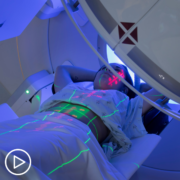Endometrial cancer treatment and research is evolving quickly. Dr. Emily Ko provides an update on new and emerging approaches, explains how these therapies work to treat endometrial cancer, and shares tips for partnering with your team on key decisions.
Related Programs:
Transcript:
Katherine:
Hello, and welcome. I’m your host, Katherine Banwell. Today’s program focuses on helping patients with endometrial cancer learn more about evolving research and treatments. We’re also going to discuss how patients can collaborate with their team on care decisions. Before we meet our guest, let’s review a few important details. The reminder email you received about this program contains a link to program materials. If you haven’t already, click that link to access information to follow along during the webinar.
At the end of the program, you’ll receive a link to a program survey. Please take a moment to provide feedback about your experience today in order to help us plan future webinars. And finally, before we get into the discussion, please remember that this program is not a substitute for seeking medical advice. Please refer to your healthcare team about what might be best for you. Well, let’s meet our guest today. Joining us is Dr. Emily Ko. Dr. Ko, welcome. Would you please introduce yourself?
Dr. Ko:
Surely. Thank you so much. My name is Dr. Emily Ko, and I am a gynecologic oncologist. Currently, I’m an associate professor at the University of Pennsylvania, and as part of my daily work, I see patients, I provide surgical and medical treatments for gynecologic cancers, and I also am a researcher involved particularly in endometrial cancer.
Katherine:
Thank you so much for taking the time out of your schedule to join us today.
Dr. Ko:
Thank you.
Katherine:
Well, let’s start by learning about the latest research news. Just this June, endometrial cancer researchers from around the world met to discuss their findings at the annual American Society of Clinical Oncology meeting, or ASCO, in Chicago. Can you walk us through the highlights that patients should know about?
Dr. Ko:
Sure. So, the ASCO meeting is a very big meeting that happens once a year in June, and really, it is a national – actually, international – meeting where the biggest breakthroughs in cancer therapy are really presented and discussed.
So, within the field of gynecologic cancer and specifically endometrial cancer, we really saw a couple breakthrough clinical trial results, if you will. The two specific trials that have hit the spotlight – and, it was presented at ASCO; they were also previously presented at the Society of Gynecologic Oncology annual meeting in March of 2023. These two trials – one of them is called GY018, and the other one is called RUBY, and these two trials specifically were geared at patients with endometrial cancer of either advanced stage, meaning stage III or IV at diagnosis, or patients who have recurrent endometrial cancer.
And, these both trials were very large, multisite, international trials enrolling a huge number of patients. They were randomized controlled trials, meaning that they were specifically testing what we call a standard therapy, Taxol-carboplatin, versus a standard therapy plus a newer agent, and that newer agent falls in the realm of an immunotherapy drug.
So, with this kind of novel approach, where we’re combining standardly used chemotherapy plus a newer immunotherapy drug, the question was if you did this combination, would patients have a better outcome? And, in fact, the groundbreaking news was that yes, patients did have a better outcome with this new combination of therapy, and this was shown in various forms of results.
One of the primary outcomes is always something called survival, and with the GY018, they looked at progression-free survival as a primary outcome, and it did show that patients on this new combination did better with progression-free survival. And the difference was about median of about three months. Now, that may not sound like a whole lot. However, in the realm of cancer therapy, when you take a very large group of patients, that was a meaningful difference that was statistically significant.
And furthermore, as we’re moving forward with our therapy drugs, we are moving into this era of targeted therapy, precision medicine, where we’re really trying to hone into more the specifics of the biology of each person’s cancer, and not treating everyone the same.
What’s interesting with these two trials is when they looked at different subpopulations of patients with advanced or recurrent endometrial cancer, whether they had a type of endometrial cancer that was considered MSI-high, or a microsatellite instable type of cancer, which basically refers to a certain biology of these endometrial cancers, it has to deal with how the cells – the cancer cells – behave, how they’re able to not follow the rules and be able to replicate themselves.
The patients who are MSI-high particularly had a really great response with this chemotherapy, so it was even beyond just a three-month difference. With that being said, even in patients who are what we call microsatellite-stable, who didn’t have this unique signature, they still saw a benefit with this novel combination, and to add to that, the nice thing about it is the toxicities were not bad. Even this new combination was very well-tolerated.
It was not a high rate of severe toxicities or side effects, if you will, and that actually, the great majority of patients were able to stay on this therapy and really get through – complete the therapy course.
So, there are some sort of nuanced differences between the two trials I mentioned, GY018 versus the RUBY. And some of those details are with regards to the even specific subtype of endometrial cancer, which we haven’t talked about yet, for example, uterine carcinosarcoma versus uterine serous carcinoma, uterine clear cell, uterine endometrioid – these are all specific subtypes of endometrial cancer. So there are some nuances where the RUBY trial was able to include patients with uterine carcinosarcoma, whereas the GY018 did not.
But suffice it to say, now we have enough data that virtually all endometrial cancer patients with advanced stage, regardless of what histology, there is essentially a trial that can apply to you where it demonstrated this added benefit to doing this novel combination, and that was found with microsatellite-stable patients as well as microsatellite-instable in both randomized controlled trials that I mentioned.
Katherine:
Such exciting news! That’s great! Well, beyond ASCO, Dr. Ko, are there other research or treatment advances that patients should know about?
Dr. Ko:
Certainly. Like I mentioned, we’re really moving towards the realm of treating with a targeted therapy approach, and within endometrial cancer, the prior paradigm was much simpler, but really not in the space of target therapy. So, for example, what does that mean?
So, as we’re realizing that there are very unique biologic signatures to different patients’ endometrial cancer – there could be, for example, some cancers that are particularly receptive to hormonal therapy, meaning their specific cancer, when we send it for detailed – we call it genomic or somatic testing, we can discover, oh, they have estrogen-receptor-positive, progesterone-receptor-positive, and so, those type of cancers may be very responsive to hormonal-based therapy, and in that space, we have a standard available drugs, but we also have clinical trials that are trying newer drugs.
If, for example, the standard aromatase inhibitor or the standard progesterone agent may be helpful, but there are even more in that space that this point – CDK inhibitors that you can combine with these aromatase inhibitors or hormonal agents that have been around for longer that have shown a lot of promise, a lot of data in breast cancer. But now we’re realizing, wow, there could be some efficacy in endometrial cancer as well, so that’s just one example.
And there’s other unique biologic gene signatures, again, kind of a good list now out there, that are being studied in various clinical trials, whether they’re PARP inhibitors, whether they’re drugs that target CCNE1, whether they’re drugs that target ARID1A, so there are actually many more that are available. So, they’re really expanding the opportunity for treatment for endometrial cancer patients.
Katherine:
Well, you just mentioned clinical trials, and I think it’s a good topic to cover a little bit. Why is it important for patients to actually consider enrolling? What are the benefits for them?
Dr. Ko:
Sure.
So, while we certainly have a good armamentarium of standard-of-care therapies already, and I should mention that does include our classic chemotherapy drugs like paclitaxel (Abraxane), carboplatin (Paraplatin), and even doxorubicin (Adriamycin), if you will, or doxorubicin Hcl (Doxil), there are the immunotherapy drugs now that have become standard of care as well, like pembrolizumab (Keytruda), but sometimes, despite using those best available drugs, the cancer unfortunately either continues to grow or you had a good response, but somehow it shows up again – the cancer shows up again – and so, then, we’re looking for additional opportunities, additional therapies.
And so, some of the best opportunities are actually to consider these clinical trials. The way that clinical trials are designed is that they always are going to provide you at least a backbone of a standard available therapy, so you’re never going to get less than what would be considered standard of care.
But, what they’re doing is they’re usually partnering another drug – a more novel therapy – or they’re basically testing a more novel therapy that could be more targeted, that could potentially have better efficacy than what’s already available standardly. And so, the value of that is that you could have an opportunity to have a therapy that could work even better.
When you’ve tried something already, unfortunately, the cancer has grown, there is still opportunity, and while you’re on a clinical trial, I think one of the huge benefits is it’s very regulated. You are monitored so closely because at the base of all of this is safety. There is never going to be a drug or therapy that’s going to be administered to a patient without ensuring that there’s absolute safety for that patient, and so, that’s a way that you really have opportunity to get more treatment that could really help your cancer condition and do it in a very, very safe, formal fashion.
Katherine:
And ultimately help others as well, in the future.
Dr. Ko:
Exactly, absolutely, because as you’re participating in this process – and, of course, it’s a voluntary process to participate on a clinical trial, so we so appreciate all the patients who, in the past, have participated and are willing to participate in the future, but allows us also to really gather a lot of information to really inform cancer treatment for all the patients coming down the road, and those could be anyone. They could be our neighbors, our friends, our own family members, and that could really be so helpful to everyone that’s going through this type of thing.
Katherine:
Absolutely, yeah. I’d like to back up a bit and talk about what endometrial cancer is. It’s often referred to as uterine cancer. So, are they the same thing? Are these terms interchangeable?
Dr. Ko:
Sure, it’s a great question. So, endometrial cancer refers to cancer that starts in what I call the lining of the uterine cavity. So, inside the uterus, there’s a uterine cavity, and there’s a tissue that coats that cavity, and that’s called the endometrium. So, endometrial cancer is basically when cancer cells start growing from that tissue. And, of course, since that exists in the uterus, of course, it’s considered uterine cancer, and we’re just being a little bit more specific when we say endometrial cancer. But, of course, endometrial cancer is the most common form of uterine cancer by far, so in some ways, it’s almost – it’s synonymous.
Katherine:
How is endometrial cancer staged?
Dr. Ko:
So, the most classic, rigorous way to stage endometrial cancer is through a surgical procedure. So, what that usually involves is it does include a hysterectomy, removing the uterus and the cervix, usually also includes removing the fallopian tubes and the ovaries.
And, at the same time, the surgeon will do a very thorough assessment of the abdominal pelvic cavity, basically looking around all those areas to see if there’s any signs of visible disease, anything they can see that looks like it could be tumor deposits in the abdominal cavity. If anything is seen, those deposits will be removed and biopsied, so that’s part of the staging procedure.
And additionally, it’s important to try to assess the lymph nodes, typically. So, there are lymph nodes in the pelvic area, and then, higher up along the aortic area, and so, there are different surgical techniques that we can use to basically test or sample some of those lymph nodes, be able to remove them, send them to the pathologist, look under the microscope to see if there are any microscopic cancer cells that have traveled to those lymph nodes.
So, that is all part of a surgical procedure, and with all the information collected from those tissue samples that are removed from the body and sent to the pathologist, but the pathologist then reviews all of that under a microscope, and then can issue a very thorough report describing where the cancer cells are located, and by definition, where the cancer cells are located then defines what the stage is of the cancer.
Katherine:
Can you give me an example?
Dr. Ko:
Of course. So, for example, if the cancer cells are located only in the uterus, and they’re not found anywhere else, then that is a stage I. If the cancer cells have traveled to the cervix area specifically, this we call a cervical stroma, that becomes a stage II. If the cancer cells have, for example, traveled to the fallopian tubes, or the ovaries, or the lymph nodes, then that becomes a stage III, and there are sort of substages within those categories as well.
Katherine:
But stage III would be the highest or most severe?
Dr. Ko:
So, there’s stage III, and then there’s actually stage IV. So, if the cancer cells have traveled outside of the pelvis into the abdominal area, then we consider that a stage IV.
Katherine:
And that would be considered advanced endometrial cancer?
Dr. Ko:
Right. So, by definition, “advanced” typically refers to stage III or IV.
Katherine:
I see, okay. Now that we understand more about the disease itself, I’d like to talk about the treatments that are currently available. You mentioned chemotherapy, but what else is available for people?
Dr. Ko:
Absolutely. So, treatment for endometrial cancer is usually some combination of surgery, and then it may be followed by possibly chemotherapy, as well as radiation, and sometimes, it may be a combination of all three treatments, or sometimes, it’s a combination of one or two of those, depending on the exact stage, depending on the exact cell type, and some of the other factors.
Katherine:
Are hormonal therapies used as well, and targeted therapies?
Dr. Ko:
Yes.
Katherine:
I know they are in other cancers.
Dr. Ko:
Yes. And so, I think the question is where do those come into play? So, I would say the usual algorithm most commonly would be that surgery is done first, as the most common first step, and then, based on the information obtained from surgery and the pathology report that comes from that, then there’s usually some type of a recommendation about should there be a second stepped treatment, and that frequently can be chemotherapy/radiation.
Now, the areas where targeted therapy – for example, immunotherapy – where does that come in? So, that now has come into the – I would call it the second stage. We’re combining it with the classic chemotherapy drugs – Taxol-carboplatin, for example. That’s one example where it could come into play. Another example could come into play where a patient had gone through classic Taxol/paclitaxel and carboplatin, then had cancer come back, and so, that could be another instance where that pembrolizumab or pembro with lenvatinib (Lenvima) combination can be used in the setting of recurrence.
Now, we could also say, hey, if your cancer type has those hormonal receptors present or is some type of what we call endometrioid histology, and we think that hormonal therapy may be more effective in that case, then that could also be used in a setting where the cancer has kind of grown again, the cancer has grown back, or actually, there are certain situations where patients, for example, may not undergo a hysterectomy.
And, there are unique cases and those situations where patients are still trying to preserve their fertility, and therefore not wanting to undergo a hysterectomy, or they’re unable to undergo surgery safely. And so, in some unique situations, we may also use hormonal therapy as the mechanism to treat their cancer, and whether that is by way of a pill, whether that is by way of a progesterone intrauterine device, IUD, that is placed into the uterus, we also have situations where we tailor the therapy to the condition of the patient.
Katherine:
How are patients monitored for a recurrence, and are there approaches to help prevent a recurrence?
Dr. Ko:
Sure, absolutely. Great question. It is important to continue monitoring patients, even after they’ve gone through treatment. So, I think of it as a multifaceted approach. Usually, it includes office visits, including a physical exam. It includes a thorough intake of all of their symptoms.
It also includes – depending on the scenario – in some circumstances, regular imaging studies, such as a CT scan or MRI, and sometimes, we also do things like PET scans, and I think that does have to be tailored to the unique patient’s endometrial cancer, unique case, stage, histology, and we kind of tailor which tests we choose to do. The interval of monitoring can vary, so I would say generally speaking, it could be anywhere from three- to six-month visits, and with potentially added scans, as we talked about, and sometimes, we also do certain blood tests in certain cases where we may choose to follow a CA125 blood tumor marker.
But, I would say that there are different, definitely variants to how we choose to monitor, and there are certain resources we tend to use, such as the NCCN guidelines that providers may reference, and sometimes may even share with the patients to explain why and how we choose to do the monitoring.
Katherine:
When treating more advanced endometrial cancer disease in general, are the treatment options different than if you were treating somebody who had stage I or stage II, for instance?
Dr. Ko:
Sure, great question. So, for some patients with, say, stage I, surgery alone is enough.
For some other patients, subcategories of stage I, where we call them more high/intermediate-risk patients, they’re stage I, but there are a few features about their pathology that might make them slightly higher risk for recurrence – in those cases, we might consider a little bit of radiation after surgery, what we call adjuvant radiation or what we call radiation vaginal brachytherapy. Just three short treatments of a little bit of radiation to the top of the vagina has been shown to possibly decrease chance of recurrence in that area with very minimal side effects.
So, that would be more commonly in line with stage I. There are some subtypes that can still be what we call high-risk, even in stage I/stage II uterine serous carcinoma, uterine carcinosarcoma. In those cases, we might also recommend chemotherapy along with some vaginal brachytherapy following their hysterectomy, so that’s the early stage.
And then, with the advanced stage, yes. So, frequently, it’d be surgery first to secure the diagnosis, followed by some type of – it might be primarily chemotherapy, or it could be combination chemotherapy with radiation. And over time, I would say our paradigm for what we use for chemotherapy and radiation has changed a little bit.
If you go back a couple decades, I think radiation was used a lot – whole pelvic radiation, even just without any chemotherapy. And then, we then had more data from research clinical trials, GOG-258 or PORTEC-3, that then had given us evidence that perhaps doing chemotherapy with some combination of radiation is going to be beneficial, or even moving towards primarily radiation could be a very good option in terms of long-term benefit/long-term survival.
And, of course, that brings us to the present day, those two trials that I mentioned from ASCO, the GY018 and the RUBY, now bringing in the immunotherapy component to the chemotherapy, so there has definitely been an evolution to managing advanced stage.
Katherine:
Yes. Dr. Ko, what goes into determining a treatment approach for an individual patient? Is there key testing that helps guide a patient’s prognosis and treatment options?
Dr. Ko:
Absolutely. So, I think the key pieces of information come from several sources. First, we do take the whole patient into account, like baseline health, baseline function, meaning every day, how active are you? Are there limitations to your daily activities? Looking at baseline health conditions, what we call comorbidities. Are there other health conditions, like diabetes, heart conditions, lung condition, kidney conditions, that could really impact a patient’s overall health and wellbeing? That is always part of it, number one.
Then, we look specific to the cancer details. So, from all the pathology information, biopsies, followed by a surgical staging procedure, what exact stage, what exact substage, and we might even look at other unique features. Was there cells that got into the lymph vessels, the lymph nodes? Are there other just features from a pathology standpoint that are important, like the – I talked about microsatellite status, microsatellite instable versus microsatellite stable.
Those are all information we can gather from the tumor tissue itself. That then kind of tailors our therapy. And then, like I was saying, now we’re going into this molecular era where we can actually take that tumor tissue and even do more expanded testing on it.
So, I think it’s worthwhile to talk to your provider and say, “Hey, would it be worthwhile to send my tumor out for expanded testing, whether it’s done at your institution, at a specialized lab, or whether it’s sent out to a company that does expanded testing?” Because then, they might be able to test for 500 different genetic signatures, a much more broad panel, but that might open the door for opportunities to say, “Hey, you actually do have a very unique signature, and maybe it is worth tailoring your therapy even further.”
So, I think these are very important questions to have with your provider, and these pieces of information can help guide the prognosis. I think we’re always asking what does this mean long-term, and I think when we have all these individual pieces of information, we can then give guidance on that.
Katherine:
Well, that leads me into my next question. I wanted to get your point of view on why is it important for patients to engage in their care and their treatment decisions?
Dr. Ko:
Right. I think that it is so important. Medical treatments, I think, do work the best for the patient when the patient is truly an active participant, and what I mean by that is I think we can really understand the patient if there’s a conversation, there’s a mutual discussion, and I think every patient has unique circumstances, has unique goals, has…whether it’s just the daily whatever responsibilities, or just either health or non-health concerns that they have, we want to be able to find a treatment that fits the patient, and we realize that one treatment doesn’t fit all.
And so, the more, I think, that there is this mutual discussion, mutual understanding, then there’s a mutual decision treatment plan that is made, and there’s the more ability to modify that plan when – if you realize, oh, maybe we can tailor it, maybe we try one thing, and maybe we realize we got to change a little bit.
And, I think that with a cancer condition, it is a journey. It is not just a one-time thing. It really is a journey, and I think that the more a patient can participate throughout that journey, I think the better the outcomes for the patient, and honestly, the better the treatment course will be for everyone participating.
Katherine:
Why should a patient consider finding an endometrial cancer specialist? What are the benefits?
Dr. Ko:
So, I think naturally, an endometrial cancer specialist is a provider who spends more time thinking about the disease, reading about it, looking at what’s the newest research studies that are coming out, what are the available clinical trials here, locally, regionally, or nationally, what are other support services available for the patient in the space.
And, of course, probably the folks that do the most surgeries gear towards endometrial cancer patients, and so, I think just working in that space naturally then brings more resources and more opportunity for the patient to kind of really know what’s out there, what is the newest, and I think that really benefits the patient.
Katherine:
Thank you for sharing all this information. I’d like to close with your thoughts on the future of endometrial cancer care. Are you hopeful?
Dr. Ko:
Yes. I think that I’m especially hopeful, especially within these last even few years, of where our field is going. I want to say I think there’s so much more that needs to be done.
I don’t think we’re ready to close the books on endometrial cancer. I think this is just a wonderful opening of a chapter where we’re seeing many more therapies come about. I do think that something that is concerning is that we are seeing more cases of endometrial cancer being diagnosed – yeah, so it is absolutely true. There is very robust data that is collected by our CDC and cancer registry in the country, and it is showing that there is actually a rising incidence, that the number of endometrial cancer cases in this country is actually increasing over time, and it has –
Katherine:
Why is that?
Dr. Ko:
It’s a great question.
Katherine:
Nobody knows – the data doesn’t include that information?
Dr. Ko:
I think there’s definitely some information, there is definitely information out there. I think some of it – and this is not all of it – I think some of it is related to the increase in obesity and the increase in average weight over time, and this metabolic condition to some degree, I think, does stimulate potential risk for endometrial cancer.
However, that is not the only reason, and what is concerning is that what we’re seeing is there’s a specific rise in subtypes of endometrial cancer in certain populations, particularly the Black and Hispanic patient populations, and we’re seeing a rise in the most aggressive types of endometrial cancer in those patient populations. I think there’s a lot of research going on right now in that to try to understand why. Is it just because we’re picking it up more? I don’t think that’s the bottom line.
And, I think what we’re also realizing as we’re studying these various tumor types of endometrial cancer, they are driven by different biology. So, I think to some extent, the ones that are more maybe related to obesity or hormones and all may be slightly different – not completely separate, but that there is underlying different genetic basis for some of these cancers developing, and whether that’s a combination of underlying genes, environment, exposure, or all of the numerous factors, we just know it is happening, and so, it really is critical in my mind that the awareness and the focus and attention on endometrial cancers is really there, that we really think about it, that we share the information as much as possible, and that we can really then come to better – have more opportunity for treatments, be able to diagnose it sooner, be able to have more opportunities to treat it, and honestly, have better survival and outcomes for our patients.
Katherine:
Dr. Ko, thank you so much for joining us today. You’ve given us so much information.
Dr. Ko:
Thank you. It was my pleasure.
Katherine:
And thank you to all of our collaborators. If you would like to watch this webinar again, there will be a replay available soon. You’ll receive an email when it’s ready. And don’t forget to take the survey immediately following this webinar. It will help us as we plan future programs. To learn more about endometrial cancer and to access tools to help you become a proactive patient, visit PowerfulPatients.org. I’m Katherine Banwell. Thanks for joining us.











